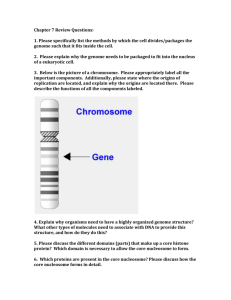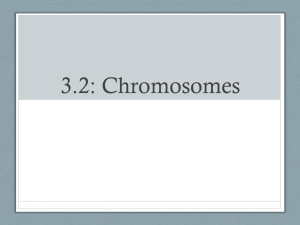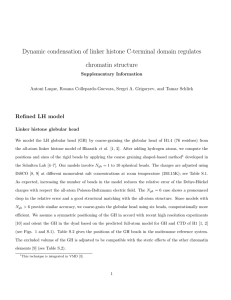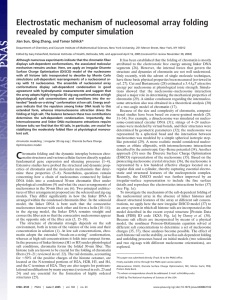Chapter 7 - Winona State University
advertisement
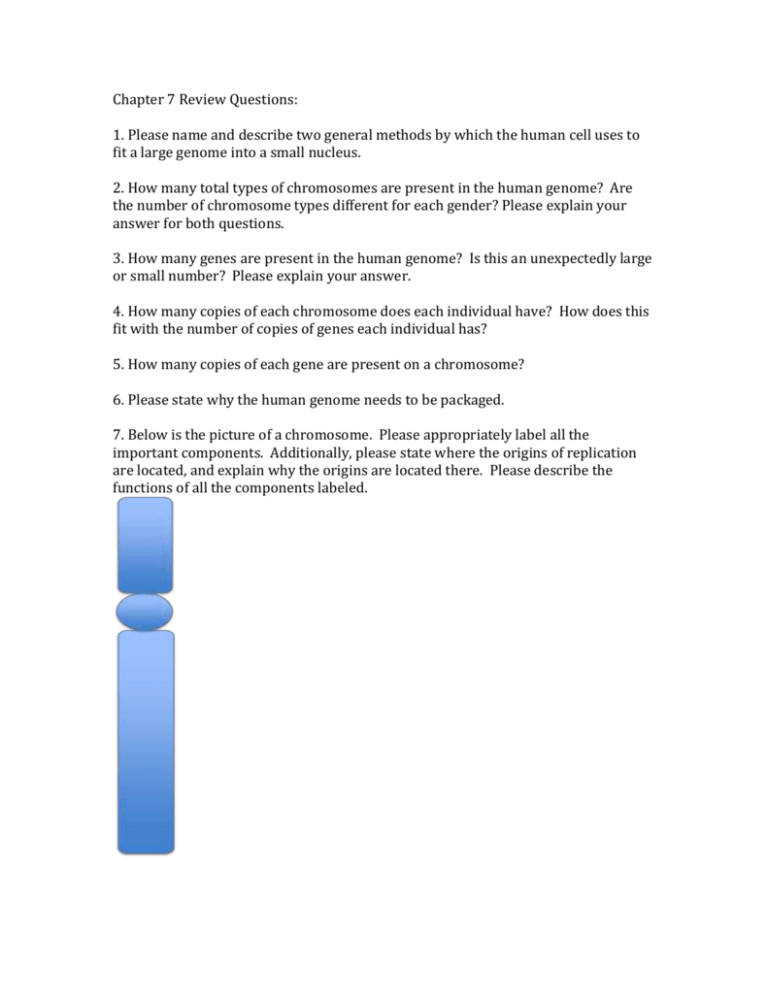
Chapter 7 Review Questions: 1. Please name and describe two general methods by which the human cell uses to fit a large genome into a small nucleus. 2. How many total types of chromosomes are present in the human genome? Are the number of chromosome types different for each gender? Please explain your answer for both questions. 3. How many genes are present in the human genome? Is this an unexpectedly large or small number? Please explain your answer. 4. How many copies of each chromosome does each individual have? How does this fit with the number of copies of genes each individual has? 5. How many copies of each gene are present on a chromosome? 6. Please state why the human genome needs to be packaged. 7. Below is the picture of a chromosome. Please appropriately label all the important components. Additionally, please state where the origins of replication are located, and explain why the origins are located there. Please describe the functions of all the components labeled. 8. An individual has Achondroplasia, one of the common causes of dwarfism in humans. This disorder is caused by a mutation in the FGFR3 gene, which is on the very end of the p-arm on chromosome 4. This mutation results in a change in DNA sequence at base 1138 in which a guanine (in the normal) to an adenine (in the mutant). There are two variations of the FGFR3 gene in the population F= variation with adenine f= variation with the guanine Please draw pictures of each copy of chromosome 4 for the genotype(s) that result in achondroplasia. 9. Why do organisms need to wind their DNA? What class of proteins are necessary for DNA winding? Please name them all. 10. Which proteins are present in the core nucleosome? Please discuss how the core nucleosome forms in detail. Please include when and how much DNA winds. 11. How many base pairs of DNA are wound around the core nucleosome? How many base pairs of DNA are wound around the entire nucleosome? 12. Does the nucleosome have an axis of symmetry? If so, please explain accurately where the symmetry lies as well as well as where the DNA enters and exits the nucleosome. 13. What characteristic of nucleosome structure allows for the bending and winding of DNA? If you wanted to unwind the DNA, how would you counteract this “characteristic?” 14. Where within the DNA structure do the histone proteins bind the DNA? Please explain in 1 sentence why the histone proteins bind there. 15. Please discuss the selenoid vs. the zig-zag model of chromatin structure. Which is physiologically relevant? Why (Please be detailed in your answer)? 16. Please list and explain the three methods the cell uses after dividing the genome into chromosomes, to compact the DNA into the cell nucleus. Within your answer please discuss the TOTAL compaction after each method. 17. Please predict the appropriate conformation for the 30 nm fiber in the organisms below (Please note that less than 40 bp of linker DNA is considered short). 1. Oak Tree: 130 bp of linker DNA 2. Mouse: 43 bp of linker DNA 3. S. pombe (fission yeast): 12 bp of linker DNA 4. Drosophila: 34 bp of linker DNA 5. Elephant 76 bp of linker DNA 6. Shark 52 bp of linker DNA 18. You are performing an experiment to determine the amount of DNA wound around the nucleosomes of the following organisms. Which enzyme would you use and why? Based on the data below, please state your conclusions, including how much DNA is protected by Histone H1. a. Coyote-low concentration: bands in multiples of 177 bp Coyote- high concentration: single band at 141 bp b. Human-low concentration: bands in multiples of 180 bp Human-high concentration: single band at 147 bp c. Lion- low concentration: bands in multiples of 164 bp Lion-high concentration: single band at 126 bp 19. You wish to do an experiment in which you determine the amount of DNA wound around both a core nucleosome, as well as the total nucleosome. Which experiment would you perform, and why? 20. Please describe in detail how histone acetylation affects chromatin winding. In the process of your description, please include the enzymes that are responsible for changing histone acetylation states. 21. You are interested in studying expression of the FBN1 gene which is implicated in Marfan’s syndrome gene. Upon examination of your expression data from a normal healthy person you find that the FBN1 gene is expressed to the following levels in each cell type: a. epidermal cell: low b. neuron: high c. muscle cell: high d. kerotinocyte: high e. vascular endothelial cell: high f. pancreatic cell: low Please state which type of chromatin your gene should be found in for each cell type. 22. Which type of chromatin takes up more volume within the nucleus? In which type of chromatin is most of the DNA found? Please explain why your answers for each question are the same or different. 23. Please list three different methods by which the cell can modify chromatin structure, and briefly describe how they do this.
